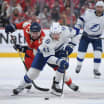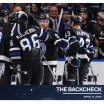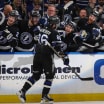Mishkin's Musings: Three thoughts at the halfway point
Dave Mishkin on playoff positioning, line shuffling and team defense

© Scott Rovak/Getty Images
The Lightning Are In A Solid Playoff Position. Certainly, this isn't some new revelation. The Lightning have done well to 'munch points', as Jon Cooper likes to say, throughout the season. But the halfway point is a good time to take stock of their standings position and points pace.
As I've written several times this season in this space, teams that amass 12 points in every 10-game segment make the playoffs. Almost without exception. Since the league went to its current points format (no ties) in 2005-06, there has been only one team with 96 points that missed the playoffs - the 2014-15 Boston Bruins. But clubs that hit their playoff pace will be at 96 points through 80 games and they'll still have two more games on the schedule. There has never been a team with 98 points that failed to qualify.
The Lightning have completed four of their eight 10-game segments and they've accumulated at least 12 points in every one of them. In the second segment, they collected 13 points. From games 21-30, they banked 16 points. So heading into the Game 41-50 segment, the Lightning had five 'bonus' points. They kicked off this current segment with a win last night in St. Louis.
The top three teams in each division automatically qualify for the playoffs. The Lightning are in third place, four points behind second-place Toronto. Not one of the five Atlantic teams behind them has maintained playoff pace.
The Lightning's good work in the first half does not guarantee them a postseason berth. They'll need to keep munching points in the final 41. But there's no question that they've put themselves in an advantageous standings position.
Rotating Stamkos and Hagel. For much of this season, Brandon Hagel has been playing on a line with Brayden Point and Nikita Kucherov. Steven Stamkos has skated with Alex Killorn. Through the middle of December, Nick Paul was the third member of that line. Since then, it's been Anthony Cirelli, who had offseason surgery and made his season debut at the start of December.
In some of the games since Cirelli joined Stamkos and Killorn, Jon Cooper has swapped Stamkos and Hagel. Stamkos moves onto a line with Point and Kucherov while Hagel joins Cirelli and Killorn. These are not 'new' linemates for Stamkos and Hagel, of course. Stamkos has played frequently in the past with Point and Kucherov. Hagel, Cirelli, and Killorn formed the Lightning's 'shutdown' line in the playoffs last year.
Cooper will mix up his lines within a game if he feels his team needs a spark. On other occasions, he makes a strategic swap - he often sends out Stamkos with Point and Kucherov for a shift after a penalty kill or at the end of a period. But in the last couple of games, he's done it for more than just a few shifts. Versus Vancouver on Thursday, Hagel played much of the second half of the game with Cirelli and Killorn - the three were matched against the Elias Pettersson line. The move worked. After the change, Cirelli's line accounted for two even-strength goals while Stamkos, Point, and Kucherov teamed up for one even-strength tally. On Saturday in St. Louis, Cooper did it again. After starting the game with the usual combinations, he began periodically swapping Stamkos and Hagel. Then, after the Lightning successfully killed off a penalty early in the third, he used Hagel, Cirelli, and Killorn for the rest of the game to match against the dangerous Robert Thomas-Jordan Kyrou-Pavel Buchnevich line.
We'll see if, as the second half gets underway, Cooper continues to reunite his effective checking line from last year's playoff run and gets Stamkos more regularly out on the ice with Point and Kucherov (during non power play situations).
Team Defense Tightened Back Up on Saturday. From late November through January 3, the Lightning defended very tightly. Beginning with their game in Boston on November 29, the Lightning held the opposition to two goals or less in 12 of 15 games. (The game-by-game results do not reflect those numbers because, for the purposes of examining their team defense, I removed empty-net goals allowed from this equation. For the record, they gave up seven empty-netters over four games, which were their only losses during that timeframe.)
But starting with their contest in Minnesota on January 4, the Lightning allowed more than two goals in four consecutive games. Their penalty kill, which had yielded only two opposition goals during the entire month of December, gave up four power play goals during those contests (including two costly five-on-three tallies in Winnipeg on January 6). In both of their home wins last week over Columbus and Vancouver, the Lightning surrendered a pair of third period goals.
But against the Blues on Saturday, the Lightning looked more like the team that defended so effectively during that 15-game stretch. They held the Blues to only two goals, killed all three penalties they took, and, after grabbing a 4-2 lead through two periods, locked things down in the third period so St. Louis wasn't able to mount a comeback rally.
That's the sort of team 'D' the Lightning want to display consistently through the second half of the season.


















